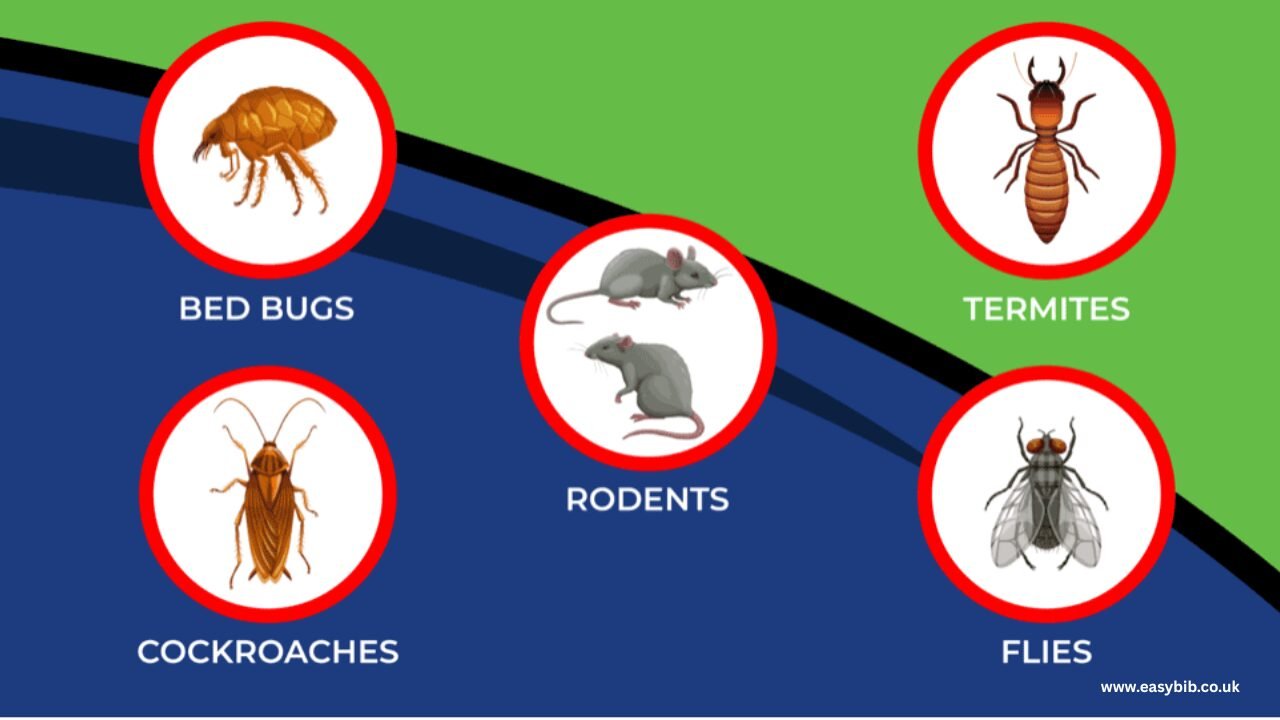Common Types of Pests Found in Commercial Buildings and What Attracts Them

Pests can be a significant concern for both large and small businesses. Commercial spaces, whether it’s a bustling office, a busy restaurant, or a quiet retail store, can attract a variety of pests that affect the cleanliness, health, and overall environment of the establishment. Identifying the common types of pests that invade commercial buildings, understanding what attracts them, and knowing where they hide can help businesses take proactive measures to prevent infestations.
Types of Pests in Commercial Buildings
1. Cockroaches
Cockroaches are notorious for invading commercial spaces, especially kitchens, bathrooms, and storage areas. These pests are known to carry harmful bacteria and allergens, posing serious health risks to employees and customers.
What Attracts Them:
Warmth, moisture, and food waste are key attractants for cockroaches. Areas like kitchens and restaurants with unsealed trash or spills create ideal breeding grounds.
Where They Hide:
Cockroaches love dark, moist environments. They are often found hiding in cracks near plumbing, around drains, behind refrigerators, and in storage areas.
Impact:
Cockroaches can contaminate food and surfaces, leading to potential outbreaks of foodborne illnesses. Their droppings and body parts can trigger allergic reactions, especially in people with sensitive allergies.
2. Rodents (Mice and Rats)
Rodents are a common sight in commercial buildings, particularly in restaurants, warehouses, and storage facilities. Because they can squeeze through tiny gaps, they’re challenging to keep out and control.
What Attracts Them:
Rodents are drawn to easy access to food, especially in poorly sealed storage areas or near garbage. They also seek warmth and shelter, making commercial buildings an ideal habitat during colder months.
Where They Hide:
Rodents can hide in walls, ceilings, basements, attics, and storage rooms. They are known to nest in areas with accessible food and materials, such as cardboard or insulation.
Impact:
Rodents can damage property by chewing on wires, insulation, and structural materials. They are also known to spread diseases such as Salmonella and hantavirus through their droppings and urine.
3. Ants
Ants are small but persistent pests that can infest any commercial building, especially those in the food service industry. The most common ants found in commercial spaces are the odorous house ant and the carpenter ant.
What Attracts Them:
Ants are attracted to sugary substances, food crumbs, and moisture. They leave behind a scent trail that guides other ants to food sources.
Where They Hide:
Ants often travel along walls and baseboards, entering through cracks or around windows and doors. They may establish nests in walls, under floors, or in heating, ventilation, and air conditioning (HVAC) systems.
Impact:
Ant infestations are not just a nuisance; they can lead to contamination of food products and surfaces. Carpenter ants can seriously damage wooden structures by tunneling through the wood to build their nests.
What Attracts Pests to Commercial Buildings?
Understanding what attracts pests to your commercial space is key to preventing infestations. Here are some common factors that invite pests into your building:
1. Food Waste and Improper Sanitation
One of the leading causes of pest infestations is food waste. Leftover food scraps, spills, and improperly sealed trash can attract a variety of pests, including rodents, cockroaches, and ants. Ensuring your business is regularly serviced by commercial pest control services can help prevent pest problems before they get out of hand.
2. Moisture and Leaks
Moist environments attract pests like cockroaches, rodents, and termites. Leaky pipes, damp basements, and poor drainage systems provide a perfect breeding ground for pests. Regular inspections and repairs can help reduce humidity and keep pests away.
3. Clutter and Cardboard Boxes
Rodents, bed bugs, and ants often use cardboard and cluttered areas as hiding spots. For businesses with large amounts of stock, such as warehouses and retail stores, it’s essential to store materials off the floor and keep the area tidy.
Where Do Pests Hide in a Business Setting?
Pests are experts at finding hidden places to live and breed.
1. Storage Rooms and Basements
Storage rooms, especially those with old boxes and unused materials, can be a hotspot for pests. Basements, with their dark and often moist conditions, are prime breeding grounds for cockroaches, rodents, and termites.
2. Drains and Plumbing
Leaky pipes, clogged drains, and standing water are perfect for pests like cockroaches, flies, and ants. Plumbing systems can also serve as entry points for pests if there are any gaps or cracks.
3. Break Rooms and Kitchens
In commercial kitchens and break rooms, food waste and spills can attract pests like ants, flies, and cockroaches. These areas need to be cleaned regularly, and food should be stored in sealed containers.
READ MORE
Conclusion
Pest infestations are a serious concern for businesses across industries. Understanding the types of pests that commonly invade commercial buildings, what attracts them, and where they hide can help you take proactive steps to prevent them. By maintaining proper sanitation, sealing entry points, and addressing moisture issues, you can keep your business pest-free and avoid the negative consequences they bring.
FAQs
1. How can I prevent pests in my commercial space?
Regular cleaning, proper waste management, sealing cracks and entry points, and maintaining plumbing systems are key to preventing pests from invading your commercial space.
2. Are bed bugs a common issue in offices?
While bed bugs are more common in hotels and homes, they can also infest office spaces with upholstered furniture. Regular inspections and prompt action can help address any bed bug problems.
3. What symptoms indicate an infestation of rodents?
Signs include droppings, gnaw marks on materials, and squeaking or scurrying noises, especially at night. You might also notice urine stains or smell a musky odor.
4. How often should I schedule pest control for my business?
For most businesses, quarterly pest control treatments are recommended. However, if you’re dealing with frequent issues, monthly inspections might be necessary.
